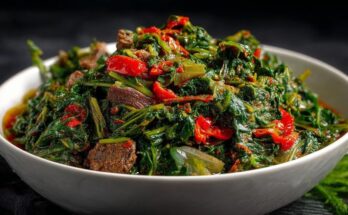Chili Soup Recipe: Chili soup is one of those comforting dishes that can warm you up on a cold day, feed a large crowd, and be adjusted to suit almost any dietary preference. Unlike chili con carne, which tends to be thick and hearty, chili soup has a lighter, brothier base while still keeping that bold, spicy kick. This makes it a versatile meal—you can enjoy it as a main course with bread, as a side dish, or even as a quick lunch that tastes better the next day.
What Makes Chili Soup Special
The beauty of chili soup lies in its balance. You get the protein-packed goodness from beans and meat (or plant-based alternatives), the richness of tomatoes, the warmth of spices, and the comfort of a broth that ties everything together. Unlike some complicated recipes, chili soup doesn’t require gourmet skills—it’s about layering flavors step by step. Whether you’re a beginner cook or an experienced one, this recipe is approachable and forgiving. You can easily adjust spice levels, swap ingredients, or make it in bulk for meal prepping.
A Brief History of Chili Soup
Chili, in its various forms, has a long history tied to Mexican and Tex-Mex cuisines. Traditional chili is known for being thick and stew-like, often served without beans in Texas-style recipes. Chili soup, on the other hand, evolved as a lighter alternative that still captures the essence of chili while being easier to digest and serve in larger portions. Its popularity grew in American households because it’s budget-friendly, adaptable, and family-friendly. Over time, chili soup became a go-to dish for gatherings, game nights, and weeknight dinners.
Why This Recipe Works for Everyone
What makes this particular chili soup recipe stand out is its flexibility. You can make it spicy or mild, vegetarian or meaty, hearty or light—it’s all about your preferences. This recipe will guide you step by step, so even if you’ve never made soup before, you’ll end up with a delicious bowl of chili soup that tastes like it came straight from a cozy kitchen. Plus, it stores well and often tastes even better the next day, as the flavors continue to blend.
Ingredients You’ll Need
Before jumping into cooking, let’s go over everything you’ll need. The ingredients are simple and easy to find in any grocery store, but each plays a role in building the depth of flavor that chili soup is known for.
Main Ingredients for Chili Soup
- Ground beef or turkey (1 lb) – A classic base for chili soup. Turkey makes it lighter, while beef adds a richer flavor.
- Kidney beans (2 cans, drained and rinsed) – Essential for texture and protein. You can also use pinto or black beans.
- Diced tomatoes (2 cans, 14.5 oz each) – Adds acidity and freshness. Fire-roasted tomatoes bring extra smokiness.
- Tomato paste (2 tbsp) – Concentrates the tomato flavor and thickens the broth slightly.
- Onion (1 large, chopped) – A must-have for depth and aroma.
- Bell pepper (1, diced) – Adds sweetness and balance to the spices.
- Garlic (3–4 cloves, minced) – Boosts flavor and ties everything together.
- Beef or chicken broth (4 cups) – The liquid base that keeps the soup light yet flavorful.
Spices and Seasonings for Flavor
- Chili powder (2 tbsp) – The heart of chili flavor.
- Ground cumin (1 tsp) – Adds warmth and depth.
- Paprika (1 tsp) – Smoked paprika works best for an extra kick.
- Oregano (1 tsp, dried) – Gives it a herby undertone.
- Salt & black pepper (to taste) – Balances everything out.
- Red pepper flakes or cayenne (optional, ¼ tsp) – For those who love heat.
Optional Add-ons for Extra Taste
- Corn (1 cup, frozen or canned) – Adds sweetness and texture.
- Zucchini (diced) – A healthy addition that absorbs flavor well.
- Hot sauce (few drops) – For spice lovers.
- Shredded cheese & sour cream (for garnish) – Optional toppings that take the soup to another level.
- Fresh cilantro or parsley (for garnish) – Adds freshness at the end.
Substitutions for Dietary Preferences
- Vegetarian version – Replace meat with extra beans, lentils, or crumbled tofu.
- Low-carb/keto version – Skip the beans and add more low-carb veggies like cauliflower or spinach.
- Gluten-free – Naturally gluten-free, just double-check canned ingredients and broth.
- Vegan – Use vegetable broth and plant-based protein instead of meat.
Kitchen Tools and Equipment
To make the cooking process smooth and hassle-free, it helps to have the right tools ready before you start.
Essential Cooking Tools
- Large soup pot or Dutch oven – A heavy-bottomed pot distributes heat evenly and prevents burning.
- Wooden spoon or spatula – For stirring without scratching the pot.
- Measuring cups and spoons – To ensure accurate seasoning.
- Sharp chef’s knife and cutting board – For prepping vegetables.
Helpful Gadgets to Speed Up Cooking
- Garlic press – If you don’t like mincing garlic by hand.
- Can opener – Since canned beans and tomatoes are key ingredients.
- Immersion blender (optional) – If you want a slightly creamier texture by blending part of the soup.
- Slow cooker or Instant Pot – If you prefer a “set it and forget it” method.
Preparing the Ingredients
One of the keys to stress-free cooking is prepping everything before you turn on the stove. Known as “mise en place” in culinary terms, it ensures you’re not scrambling to chop onions while your garlic is burning.
Chopping Vegetables Correctly
When chopping onions, aim for small, even pieces so they cook quickly and evenly. Bell peppers should be diced into bite-sized chunks, while garlic needs to be finely minced to release its flavor fully. If you’re adding extra veggies like zucchini or carrots, cut them into uniform pieces so they cook at the same rate.
Prepping Meat for Chili Soup
If you’re using ground beef or turkey, you don’t need much prep—just keep it chilled until you’re ready to brown it. For chicken or plant-based proteins, cut them into small cubes or crumbles. Seasoning meat lightly with a pinch of salt before cooking helps lock in flavor.
Measuring Spices Accurately
Spices are the soul of chili soup, but adding too much or too little can throw off the balance. Use proper measuring spoons instead of eyeballing, especially if you’re new to cooking. To maximize flavor, mix your spices in a small bowl beforehand—this ensures even distribution when you add them to the pot.
Step-by-Step Guide to Making Chili Soup
Now that your ingredients and tools are ready, it’s time to bring everything together. Cooking chili soup is a gradual process where each step builds flavor.
Step 1 – Sautéing the Base Ingredients
Start by heating 2 tablespoons of olive oil in your large soup pot over medium heat. Once the oil is hot, add chopped onions and bell peppers. Sauté for about 5 minutes until they start to soften and become fragrant. Next, add minced garlic and stir for about 1 minute—be careful not to burn it, as garlic can turn bitter quickly.
This first step might seem simple, but it’s crucial. Sautéing vegetables in oil unlocks their natural sweetness and creates a flavorful base. Think of it as the foundation of your soup; without it, the rest of the ingredients won’t shine. Once the onions are translucent and the garlic releases its aroma, you’re ready for the next stage—cooking the protein.
Step 2 – Cooking the Meat (or Meat Alternatives)
Once the base of onions, peppers, and garlic is fragrant, it’s time to add your protein. If you’re using ground beef or turkey, crumble it directly into the pot. Stir frequently and break it apart with your spoon so it browns evenly. This step usually takes about 7–10 minutes. Don’t rush it—the browning process develops rich, savory flavors that make chili soup taste hearty.
If you’re going vegetarian or vegan, now’s when you would add your plant-based alternative. Crumbled tofu, tempeh, or even lentils can take the place of meat. If you’re using beans only, you can skip this step, but you may want to sauté mushrooms first, as they give that meaty depth of flavor.
While the meat is cooking, season it lightly with a pinch of salt and pepper. You’ll add more spices later, but this small step helps build layers of flavor. Once the meat is no longer pink, drain any excess fat if you’re using beef—too much grease can make the broth heavy. Leave just enough for flavor.
Step 3 – Adding Beans, Tomatoes, and Broth
Now comes the part where the chili starts looking like chili soup. Add your drained beans, canned diced tomatoes (with their juices), and tomato paste into the pot. Stir everything well to coat the meat and vegetables. The tomato paste is especially important—it thickens the base slightly and intensifies the tomato flavor.
Next, pour in your broth. Four cups is usually perfect, but you can adjust depending on how thick or soupy you want the final dish. Give everything a good stir, making sure the tomato paste dissolves into the liquid.
At this stage, your kitchen will start smelling amazing. The beans add creaminess, the tomatoes bring acidity, and the broth creates that comforting soup texture. If you’re adding optional veggies like corn or zucchini, toss them in now so they have time to soften while the soup simmers.
Step 4 – Seasoning and Simmering to Perfection
This is the step that transforms a pot of random ingredients into a soul-warming chili soup. Add your spice mix—chili powder, cumin, paprika, oregano, salt, pepper, and cayenne (if you like heat). Stir thoroughly to make sure the spices blend evenly into the broth.
Bring the pot to a gentle boil, then immediately reduce to a simmer. Cover partially with a lid and let it cook for at least 30–40 minutes. The longer it simmers, the more the flavors mingle and deepen. Stir occasionally to prevent sticking.
As it simmers, taste the broth. Is it bold enough? Too mild? Don’t be afraid to adjust—maybe add another pinch of chili powder for warmth, or a splash of hot sauce for extra kick. Remember, chili soup is all about balance.
Step 5 – Taste Testing and Adjustments
The final step before serving is all about refinement. After simmering, taste the soup carefully. If it feels too acidic from the tomatoes, stir in a teaspoon of sugar or honey to balance it. If it needs richness, add a small knob of butter or a splash of cream. For freshness, squeeze in some lime juice or sprinkle chopped cilantro on top.
This is also when you decide the thickness. If it’s too thin, let it simmer uncovered for another 10 minutes. If it’s too thick, add a splash of broth or water to loosen it up.
Once the flavors are balanced to your liking, turn off the heat. Your chili soup is officially ready to serve.
Serving and Garnishing Chili Soup
Serving chili soup is where you can get creative. The base recipe is delicious on its own, but the toppings and sides can completely transform the experience. Think of it like dressing up a simple outfit with accessories—it makes everything more exciting.
Start by ladling the chili soup into warm bowls. Warming your bowls in the oven for a few minutes or simply rinsing them with hot water beforehand keeps the soup hot for longer, especially if you’re serving a crowd.
For garnishes, shredded cheese (cheddar, Monterey Jack, or pepper jack) melts beautifully on top of the hot soup, giving it a creamy touch. A dollop of sour cream balances the heat with coolness, while chopped fresh cilantro or parsley adds freshness. Sliced jalapeños are perfect for spice lovers, and a squeeze of lime juice brightens the entire bowl.
If you’re feeling indulgent, serve your chili soup with sides like warm cornbread, crusty baguette, or tortilla chips for dipping. For a healthier twist, pair it with a fresh green salad. The contrast between the hearty soup and crisp salad makes the meal satisfying without being overly heavy.
Tips for Making the Best Chili Soup
Even though chili soup is simple, a few tricks can elevate it from good to unforgettable.
- Toast your spices – Add them directly to the hot pot before the liquid goes in. This wakes up the flavors and gives your soup more depth.
- Use fire-roasted tomatoes – They bring a smoky richness that regular canned tomatoes can’t match.
- Let it rest – Chili soup tastes even better the next day because the flavors continue to develop overnight. Make a big batch, and you’ll thank yourself tomorrow.
- Balance the flavors – Chili should be a harmony of heat, acidity, sweetness, and savoriness. Don’t hesitate to adjust with sugar, vinegar, or citrus juice if something feels off.
- Experiment with beans – Mixing different beans (kidney, black, and pinto) adds variety in both taste and texture.
These little tweaks make a huge difference. Chili soup is forgiving, so don’t be afraid to play around until it tastes exactly how you like it.
Variations of Chili Soup
The great thing about chili soup is its adaptability. No matter your preferences or what’s in your pantry, there’s a version that works for you.
Vegetarian Chili Soup
Skip the meat and double up on beans, lentils, or tofu crumbles. Add extra veggies like zucchini, carrots, or mushrooms for bulk and flavor.
Chicken Chili Soup
Swap ground beef for shredded chicken breast or thighs. A white chili version uses chicken, white beans, and green chilies with a creamy broth.
Spicy Chili Soup
If you love heat, crank up the cayenne, toss in fresh jalapeños, or stir in hot sauce. Ghost pepper or habanero fans—this one’s for you.
Kid-Friendly Chili Soup
Tone down the spice, add corn for sweetness, and serve with shredded cheese and tortilla chips. Kids love dipping and scooping.
Slow Cooker or Instant Pot Chili Soup
For a hands-off approach, toss everything into your slow cooker and let it cook on low for 6–8 hours. Instant Pot fans can brown the meat directly in the pot, then pressure cook everything together for a quick meal.
Storing and Reheating Chili Soup
One of the best things about chili soup is how well it stores. In fact, leftovers often taste even better because the flavors have had more time to blend.
- Refrigerator: Store in airtight containers for up to 4–5 days.
- Freezer: Chili soup freezes beautifully. Portion into freezer-safe bags or containers and store for up to 3 months. Thaw overnight in the fridge before reheating.
- Reheating: Warm on the stovetop over medium heat, stirring occasionally. Add a splash of broth or water if it’s too thick. Microwaving works too, but stir halfway to heat evenly.
Meal preppers especially love chili soup because it can be made in bulk and portioned for quick lunches or dinners throughout the week.
Health Benefits of Chili Soup
Besides being hearty and delicious, chili soup is surprisingly nutritious when made with wholesome ingredients.
- Protein-packed: Between beans and meat, you get a solid protein boost.
- Fiber-rich: Beans and vegetables aid digestion and keep you full longer.
- Low-cost nutrition: Affordable ingredients make it a budget-friendly, nutrient-dense option.
- Immune-boosting: Garlic, onions, and tomatoes are loaded with antioxidants and vitamins.
- Customizable: Whether you want low-carb, vegan, or gluten-free, chili soup can be tailored to your diet.
It’s comfort food that doesn’t have to derail your health goals. In fact, it’s one of the easiest ways to enjoy a filling, wholesome meal without fuss.
Common Mistakes to Avoid When Making Chili Soup
Even though chili soup is beginner-friendly, there are a few pitfalls that can throw off the flavor or texture. Knowing these ahead of time can save you from disappointment.
1. Rushing the Simmering Process
Good chili soup needs time. If you only simmer it for 10 minutes, the flavors won’t have a chance to develop. Always let it cook for at least 30–40 minutes, and if you can, go longer. Slow cooking makes a big difference.
2. Skipping the Browning Step
Browning the meat and sautéing the vegetables is essential. If you skip this and just throw everything in the pot, you’ll miss out on those deep, caramelized flavors that set great chili apart from bland chili.
3. Overloading with Spices Too Soon
It’s tempting to dump in all the spices at once, but adding them gradually and tasting as you go helps balance the flavors. You can always add more, but you can’t take it out once it’s too strong.
4. Making It Too Thin or Too Thick
Chili soup should have a perfect balance—not watery like broth, but not so thick that it feels like a stew. Adjust with broth or let it simmer uncovered until you reach your ideal texture.
5. Forgetting to Taste Before Serving
A final taste test is non-negotiable. Maybe it needs more salt, maybe a dash of lime juice, or maybe it’s perfect. This step ensures every bowl is as delicious as it should be.
Pairing Chili Soup with Sides and Drinks
Chili soup shines on its own, but pairing it with the right sides and drinks takes the meal to another level.
Best Side Dishes
- Cornbread – A classic companion; its sweetness balances chili’s spice.
- Tortilla chips – Perfect for scooping or crumbling on top.
- Garlic bread – Adds a crunchy, savory bite.
- Fresh salad – A crisp green salad with light dressing balances the hearty soup.
Best Drinks to Serve
- Beer – A cold lager or pale ale complements chili’s spice.
- Red wine – Bold varieties like Zinfandel or Malbec pair beautifully.
- Iced tea or lemonade – Refreshing and family-friendly options.
- Sparkling water with lime – A light, bubbly contrast to the rich soup.
Pairing isn’t just about taste—it makes the whole dining experience feel more complete and satisfying.
Why Chili Soup is Perfect for Gatherings
If you’re hosting a party, game night, or family dinner, chili soup is one of the best dishes you can make. Here’s why:
- Feeds a Crowd Easily – One big pot can serve 6–8 people, and doubling the recipe is simple.
- Customizable Toppings Bar – Guests can add cheese, sour cream, jalapeños, or hot sauce to their liking.
- Budget-Friendly – Beans, tomatoes, and broth are affordable, and you don’t need expensive cuts of meat.
- Make Ahead Friendly – You can cook it the day before, and it will taste even better.
- Casual Yet Comforting – Whether it’s a casual get-together or a cozy family night, chili soup fits right in.
Hosting stress disappears when you know your meal is simmering away, ready to impress without requiring constant attention.
FAQs about Chili Soup Recipe
1. Can I make chili soup without beans?
Yes! While beans add texture and nutrition, you can skip them if you prefer. Just increase the amount of meat or vegetables to make up for the volume.
2. How do I make my chili soup less spicy?
Reduce the chili powder and cayenne. You can also serve it with sour cream or shredded cheese, which naturally cools down the heat.
3. Can I freeze chili soup?
Absolutely. Chili soup freezes well for up to 3 months. Just store in airtight containers, thaw overnight, and reheat on the stove.
4. What’s the difference between chili and chili soup?
Traditional chili is thicker, almost like a stew, while chili soup is lighter and brothier but still packed with flavor.
5. How do I thicken my chili soup if it’s too runny?
You can let it simmer uncovered to reduce liquid, stir in an extra spoonful of tomato paste, or mash some of the beans to naturally thicken the broth.
Conclusion
Chili soup is one of those recipes that proves comfort food doesn’t have to be complicated. With simple ingredients, a step-by-step process, and room for creativity, it’s a dish anyone can master. Whether you make it spicy for adults, mild for kids, or meatless for vegetarians, the result is always satisfying.
It’s budget-friendly, easy to store, and perfect for both weeknight meals and gatherings. Plus, the fact that it tastes even better the next day makes it a meal-prepper’s dream.
So grab your pot, gather your ingredients, and let your kitchen fill with the irresistible aroma of simmering chili soup. Once you take that first spoonful, you’ll understand why this recipe has stood the test of time as a family favorite.



